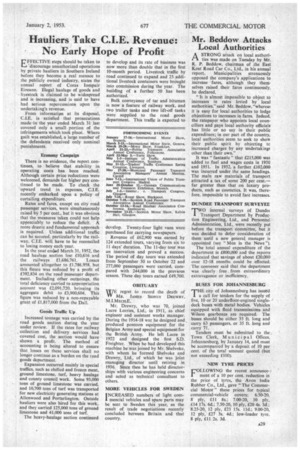Hauliers Take C.I.E. Revenue: No Early Hope of Profit
Page 31

If you've noticed an error in this article please click here to report it so we can fix it.
rFFECTIVE steps should be taken to
'discourage unauthorized operations by private hauliers in Southern Ireland before they become a real menace to the publicly owned industry, states the annual report of Coras Iompair Eireann. Illegal haulage of goods and livestock is claimed to be widespread and is increasing, and is said to have had serious repercussions upon the undertaking's revenue.
From information at its disposal, C.1.E. is satisfied that prosecutions made in the year ended March 31 last covered only a small portion of the infringements which took place. Where guilt was established, a large number of the defendants received only nominal punishments.
Economy Campaign There is no evidence, the report continues, to believe that stability in operating costs has been reached. Although certain price reductions were welcomed, demands for higher pay continued to be made. To check the upward trend in expenses, C.I.E. recently embarked upon a policy of curtailing expenditure.
Rates and fares, except on city road passenger services, were simultaneously raised by 5 per cent., but it was obvious that the measures taken could not help appreciably to reduce the deficit. A more drastic and fundamental approach is required. Unless additional traffic can be secured, particularly by the railway. CIE, will have to be reconciled to losing money each, year.
In the year endad March 31, 1952, the road haulage section lost £10,616 and the railways £1,686,761. Losses amounted altogether to £1.786.958. but this figure was reduced by a profit of £392,834 on the road passenger department. Including other outgoings, the total deficiency carried to appropriation account was £2,091,720. bringing its aggregate debit to £3,900,604. This figure was reduced by a non-repayable grant of £1,817,000 from the Dail.
Goods Traffic Up Increased tonnage was carried by the road goods section during the year under review. If the rates for railway , collection and delivery services had covered cost, the section would have shown a profit. The method of accounting is being altered to ensure that losses on these services shall no longer continue as a burden on the road goods department.
Expansion occurred mainly in special traffics, such as chilled and frozen meat, ground limestone, turf, heavy haulage and county council work. Some 93.000 tons of ground limestone was carried, and 10,700 tons of turf was transported for new electricity generating stations at Allenwood and Portarlington. Outside hauliers were also hired for this work, and they carried 125,000 tons of ground limestone and 41,000 tons of turf.
The heavy-haulage section continued to develop and its rate of business was now more than double that in the first 10-month period. Livestock traffic by road continued to expand and 25 additional livestock containers were brought into commission during the year. The building of a further 50 has been authorized.
Bulk conveyance of tar and bitumen is now a feature of railway work, and two trailer tanks and two lift-off tanks were supplied to the road goods department. This traffic is expected to develop. Twenty-four light vans were purchased for carrying newspapers.
Revenue of £62,900 was earned by 124 extended tours, varying from six to 11 days' duration. The 11-day tour was an innovation and proved a success. The period of day tours was extended from September 30 to October 22 and 277,000 passengers were carried, compared with 244,000 in the previous season. These day tours earned £49,700.
OBITUARY
VVE regret to record the death of MR. JAMES SIDNEY DREWRY,
Mr. Drewry, who was 70, joined Lucre Lorries, Ltd., in 1911, as chief engineer and assistant works manager. During the 1914-18 war he designed and produced pontoon equipment for the Belgian Army and special equipment for the British Army. He left Lucre in 1922 and designed the first S.D. Freighter. When he had developed this machine he was joined by Mr. Shelvoke, with whom he formed Shelvoke and Drewry, Ltd., of which he was joint managing director until retiring in 1936. Since then he has held directorships with various engineering concerns and acted as technical consultant to others.
MORE VEHICLES FOR SWEDEN INCREASED numbers of light corn mercial vehicles and spare parts may be sent to Sweden this year, as the result of trade negotiations recently concluded between Britain and that country.




















































































